What to do with a bee sting?
At the same time as the first spring rays, representatives of the insect order wake up, attracted by flowering plants and fruits, so it is not surprising that many people suffer from their bites. Each organism reacts differently to bee venom. What to do in case of insect bites, how first aid is provided and what are the consequences, will be described later.
Did you know? The bee sting has acquired a modern look and functionality as a result of evolution. Initially, there was a vessel on this site through which insects laid eggs.
General characteristics of bees
Bees belong to the order Hymenoptera and are relatives of wasps and ants. Science knows about 20 thousand breeds, the most common of which is the European honey plant. Bees are distributed around the world, excluding Antarctica. In the household, insects are used to produce honey and wax.

Important! In the event of an attack by several bees at the same time, a person may die. Also, a fatal outcome occurs if there is an allergic reaction to bees, and help was not provided on time.
Bee breeds
Outwardly, all bees are similar, but there is a clear classification of them. On the territory of our country there are such types:
- Central Russian. A rather large insect of a dark gray color. It is distinguished by aggressiveness.
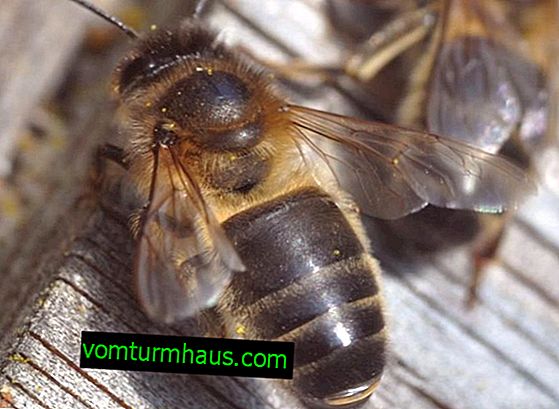
- Mountain gray Caucasian. A little smaller than the previous view. Sufficiently peace-loving insects that are weakly amenable to swarming.

- Caucasian yellow. It is similar in size to a gray mountain, but much more prolific. Color - gray, with bright yellow stripes. Loving insects.
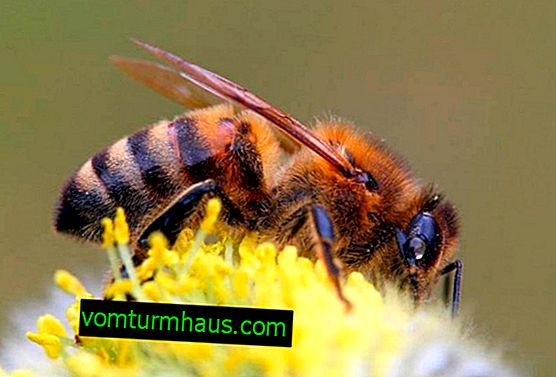
- Ukrainian steppe. Less Central Russian breed, but with a longer proboscis.
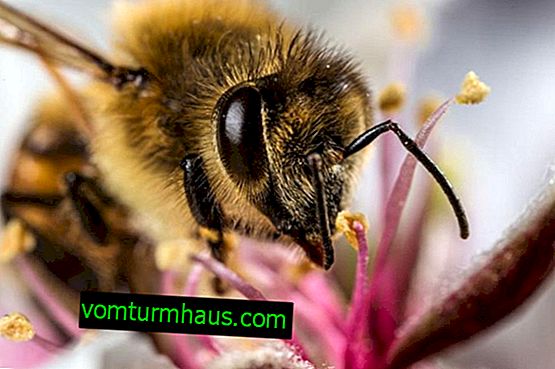
- Carpathian. Similar to the previous view. It is distinguished by its peaceful character.

- Italian Large insect. A distinctive feature is a golden color with bright yellow stripes. Loving.
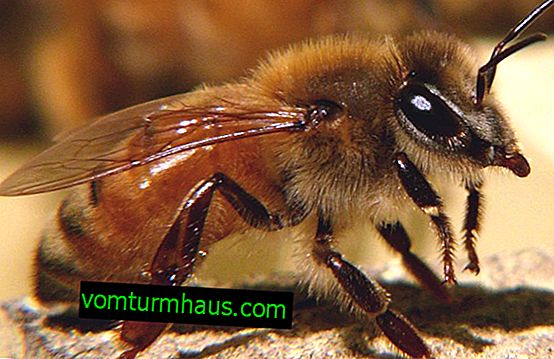
- Krainskaya. Austrian breed of gray color.
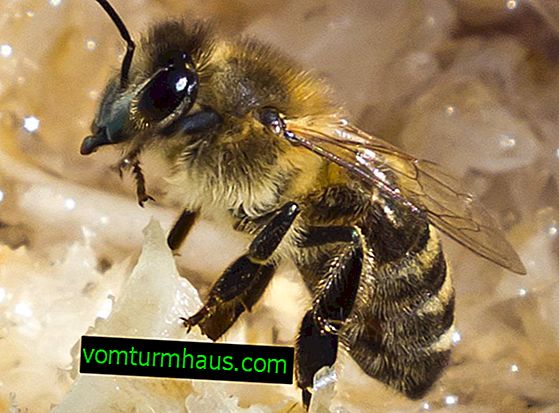
- Far Eastern. Collected the characteristics of several species. Medium in color, gray. Loving.

Bite features
Stinging the victim, the bee instinctively defends itself and releases the poison. However, she dies. The released substance, getting under the skin, spreads in the blood and leads to various results.
Harm
The reaction after stinging depends on the human body. Normally, slight swelling and redness in the bite area are considered. After a few days, the tumor disappears - the process is accompanied by mild itching. However, allergic manifestations, even anaphylactic shock, can occur. Poison is especially dangerous for children, because a fragile organism can react in different ways.
Did you know? Only working bees and the uterus have a sting.
Benefit
However, bee stings can be beneficial. Not one ancient remedy contains bee venom.
- So, stinging, bees contribute to the manifestation of the following effect:
- blood thinning, prevention of thrombosis, decreased blood coagulation;
- help in resorption of adhesions, wounds, scars;
- beneficial effect on the functioning of the kidneys;
- relief of symptoms of diseases such as osteochondrosis, arthrosis, radiculitis;
- a beneficial effect on the functioning of the nervous system;
- promoting the recovery of the genitourinary system;
- help in the fight against excess weight.
The composition of bee venom
The result of the action of bee venom can bring both positive and negative consequences. You should not be afraid of panic - it's better to figure out what its composition looks like:
- melittin;
- formic acid;
- histamine;
- hydrochloric acid;
- hyaluronidase;
- orthophosphoric acid;
- phospholipase;
- acetylcholine;
- copper;
- tryptophan;
- sulfur;
- magnesium.

- Bee venom has the following positive properties:
- antibacterial;
- sedative;
- anti-inflammatory;
- stabilization of blood pressure and hormonal levels;
- improving heart function;
- strengthening immunity.
The human body does not react negatively to all components. Mostly allergies occur due to apitoxin.
- It is this poison that causes such reactions as:
- labored breathing;
- cramps
- blue skin;
- edema;
- increased heart rate;
- paralysis.
Symptoms
When stinging occurs, sharp pain is felt, but this is not the most unpleasant sensation that accompanies an insect bite. The danger is determined by its localization - the greatest threat is damage to the head, mouth, chest. Almost immediately after a bite, itching occurs, the skin swells and reddens. A white dot appears at the point where the sting penetrates.
Important! Allergies can occur after a couple of minutes or several hours.
If the body is prone to allergic manifestations or stinging occurred on sensitive parts of the body (not in the arm), then the bite zone turns red and becomes covered with a rash. Perhaps the appearance of weakness, fever and dizziness. Sometimes a person may experience nausea, chills, and suffer from coughing and seizures.
Bee bit: what to do at home
It doesn’t matter who the bee attacked - help should be provided quickly. The speed and clarity of the action determines the degree of spread of toxins in the blood.

Standard procedures after bee vinegar include the following:
- You must first get rid of the sting. Do this manipulation with sterile forceps or clean hands. The most important thing is that there are no sting particles left under the skin. Sterility is also important - if dirt gets into the wound, inflammation will occur. The sting is not squeezed out, but gently pulled out with tweezers, being careful not to damage the pouch located next to the rod.
- Treat the damaged area with alcohol, iodine, brilliant green or hydrogen peroxide and apply ice. You can use household soap to clean the skin.
- Pure sponge, gauze or cotton wool soaked with ammonia should be attached to the bite site. Ammonia can be replaced with ethyl alcohol, a solution of manganese or soda. Such a compress is kept for a long time (not less than half an hour) - it will help stop swelling and provide disinfection of the wound.
- To prevent allergies, it is recommended to take antihistamines.
- Need to drink plenty of fluids. It is desirable that it be a drink containing glucose.
Did you know? More people die from bee venom annually than from snake venom.
A bee can sting in various parts of the body, including the head. Typically, these are the oral cavity, neck and arms.
The degree of danger depends on the location of the bite:
- Tongue or oral cavity. The most dangerous place, since such an injury can be fatal in a few minutes, even with timely assistance. Stinging in the oral cavity is painful (much more painful than in the finger). The main danger is that the affected tongue swells and blocks the airways. Unprofessional assistance in this case is impossible - an urgent need to contact the doctors. If it is impossible to get medical help, then the victim is immediately given antihistamines and put ice cubes in his mouth (will reduce swelling).
- Defeat in the neck. Slightly less dangerous than a bite in the tongue. Swelling occurs quickly, there is a blockage of oxygen access. Dangerous consequences can be avoided with the timely provision of medical care. As preliminary measures, it is recommended to give the victim antihistamines and apply a cool compress to the wound to relieve swelling and reduce pain.
- Arm or body. If one insect stings, then such an attack is not considered particularly dangerous - you can cure the victim yourself. The main thing is to provide first aid on time and competently.
- Eyes. Consider what happens if the insect bites into the eyelid - in addition to swelling of the organ of vision, complex eye diseases (inflammation of the mucous membranes, purulent processes in the eye tissues, glaucoma, cataract, etc.) can subsequently develop, up to and including loss of vision. In this case, it is impossible to be treated on your own, especially in folk methods - you should immediately contact an ophthalmologist.

Baby bite
If a baby is bitten by a baby, the right decision is to immediately go to the hospital, because a fragile body is more sensitive to bee venom than an adult. If there is no way to get the help of doctors, you can take such measures:
- Disinfect the bite area and put a cold compress - this will stop the absorption of toxins and help relieve pain. Fleece or sponge soaked in saline (teaspoon per 200 ml of water) helps a lot.
- If an allergy occurs (edema, blisters, rash), the baby immediately needs to be given an anti-allergic drug. The bite site is simultaneously treated with an antiallergic cream.
Did you know? The name "bee" is the evolved Old Russian word "bee", which came from "buzz" - buzz. In Latin, the name of this hymenoptera - mellifera - comes from the word mel (honey).
Animal bite
Our pets can also suffer from insects. You can help them if you know how to treat the wound. In general, the process consists of such manipulations:
- Lock Pet. You need to ask someone to fix the paws of the animal so that it does not twitch, and you could pull out the sting with tweezers.
- After removing the sting, rinse the wound. Suitable for such a procedure is iodine or potassium permanganate.
- If the bite occurred to the head, it is better to apply ice to the lesion site - it will reduce pain.
- In the coming days, give more water. You can also give the animal "Suprastin" or "Aspirin."

What is not worth doing?
Doctors and beekeepers give useful recommendations that must be followed to prevent unwanted problems from the effects of bee venom. But there are tips that nonprofessionals give - you should remember actions that are not recommended under any circumstances if a bee stings:
- Do not kill a stinging bee. Dead or wounded, she releases a special substance that causes aggression among her brethren, so if there are many bees nearby, this can result in a mass attack. It is better to catch it, for example, with a towel and release it.
- Do not scratch the bite site and do not rub it. Such an action only helps the poison dissolve and increases the risk of infection. It is better to have something nearby that can stop the itching - antihistamine ointment, ammonia, etc.
- Do not press on the bite area and do not try to squeeze out the sting. It also helps the poison to be absorbed into the blood faster.
- Do not drink alcohol. When ingestion of alcoholic beverages, the vessels expand, which accelerates the spread of poison.
- Natural substances (earth, clay, water from ponds) cannot be applied to the bite site - this can cause tetanus infection. There have been cases that as a result of such manipulations, the poison provoked gout.
- Do not take sleeping pills. Such drugs enhance the effect of the poison.
Important! If there are signs of an allergy (difficulty breathing, fever) or a massive attack has occurred, then the animal is taken to a veterinary clinic.
An allergic reaction to an insect bite
If after a bee attack, signs of a severe reaction to toxins are observed, you should immediately contact a doctor. But before this, the victim is provided with peace and a plentiful drink. To help with an allergic reaction, you need to correctly determine which species arose and how to treat it.
Allergic urticaria
The most common allergic symptom. Rough, slightly convex spots of red color appear on the skin of the victim. They constantly itch and are treated only with antihistamines. If the wounds look infected, you should definitely seek medical help.

Anaphylactic shock
The most dangerous condition. It is worth noting that such a reaction is rare, but it cannot be ruled out. This condition is accompanied by the following picture:
- sharp swelling of the mucous membrane of the mouth, larynx, respiratory tract;
- malfunctioning in breathing;
- pressure reduction;
- dizziness;
- loss of consciousness;
- death of a person (if he could not get adequate help on time).
Did you know? There are breeds of bees that do not have a stinger - mellrons: they live in Africa and southern America. But these hymenoptera are not harmless at all - in case of danger they attack, trying to penetrate the eyes and ears.
Help with an allergic reaction
When allergies occur, antihistamines should be taken. Also, activated carbon will help reduce the effect of poison . In the case of an acute attack, the victim should be taken to the clinic or urgent care needed. Prior to the arrival of physicians, the victim is given Diphenhydramine (Cetrin, Claritin, Suprastin, etc.) and Cordiamin. In order to lower blood pressure, warm warmers are applied. In critical situations and with tremor, it is advisable to provide professional assistance (start the heart, restore breathing, etc.).

The procedure for a dangerous allergic reaction looks like this:
- Release victim from tight clothing. Provide air access.
- Introduce adrenaline. An injection is made in the forearm, a dose of 0.5 ml.
- Inject Dexamethasone. The injection is done in the other hand, the dose is 3 ml.
- If after ¼ hours the condition does not improve, adrenaline is administered repeatedly. Norm - 0.5 ml.
How to avoid a bee sting?
In order not to bite the bees, you should adhere to these rules:
- do not drink sweet, aromatic drinks in nature;
- Do not use perfumes (lotions, colognes, etc.) near the apiary;
- when approaching the bees, do not run, do not clap your hands, do not wave your towel or newspaper;
- do not wear bright clothes when going outdoors;
- when walking barefoot, be careful not to step on the insect;
- if you plan to eat during a walk, you need to grab a remedy for bees and other insects;
- after taking sweet food, the child needs to immediately wash his hands;
- so that the baby is not bitten by insects, it is advisable to cover the stroller with a mosquito net;
- try not to sit near fruit trees, especially if spoiled fruits lie under them;
- close windows when traveling by car.
Learn how to provide first aid for a wasp sting at home.
Walking in the fresh air will be a pleasure if you know the rules that will help avoid a bee attack, as well as provide first aid for the bite of this insect.











